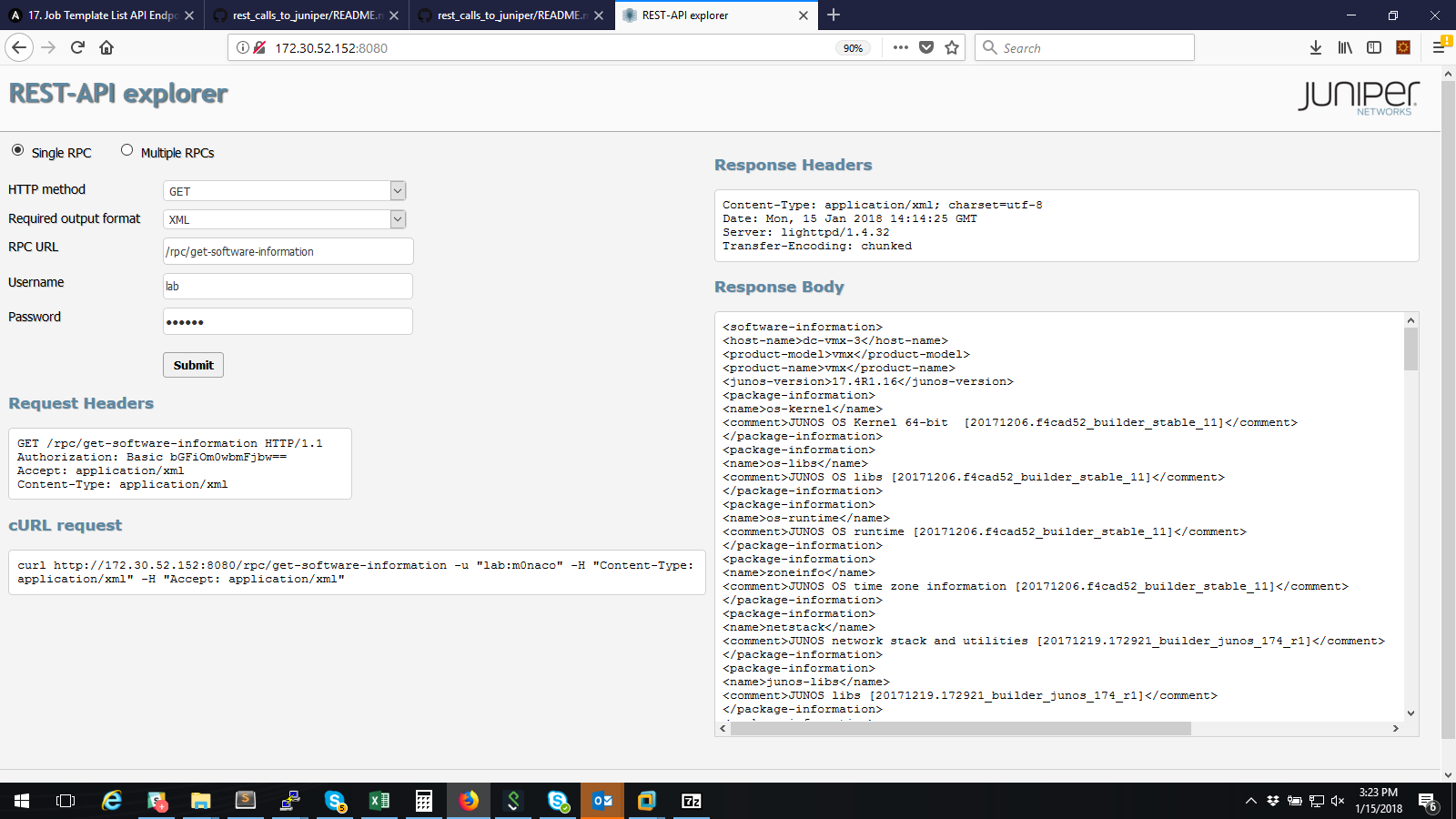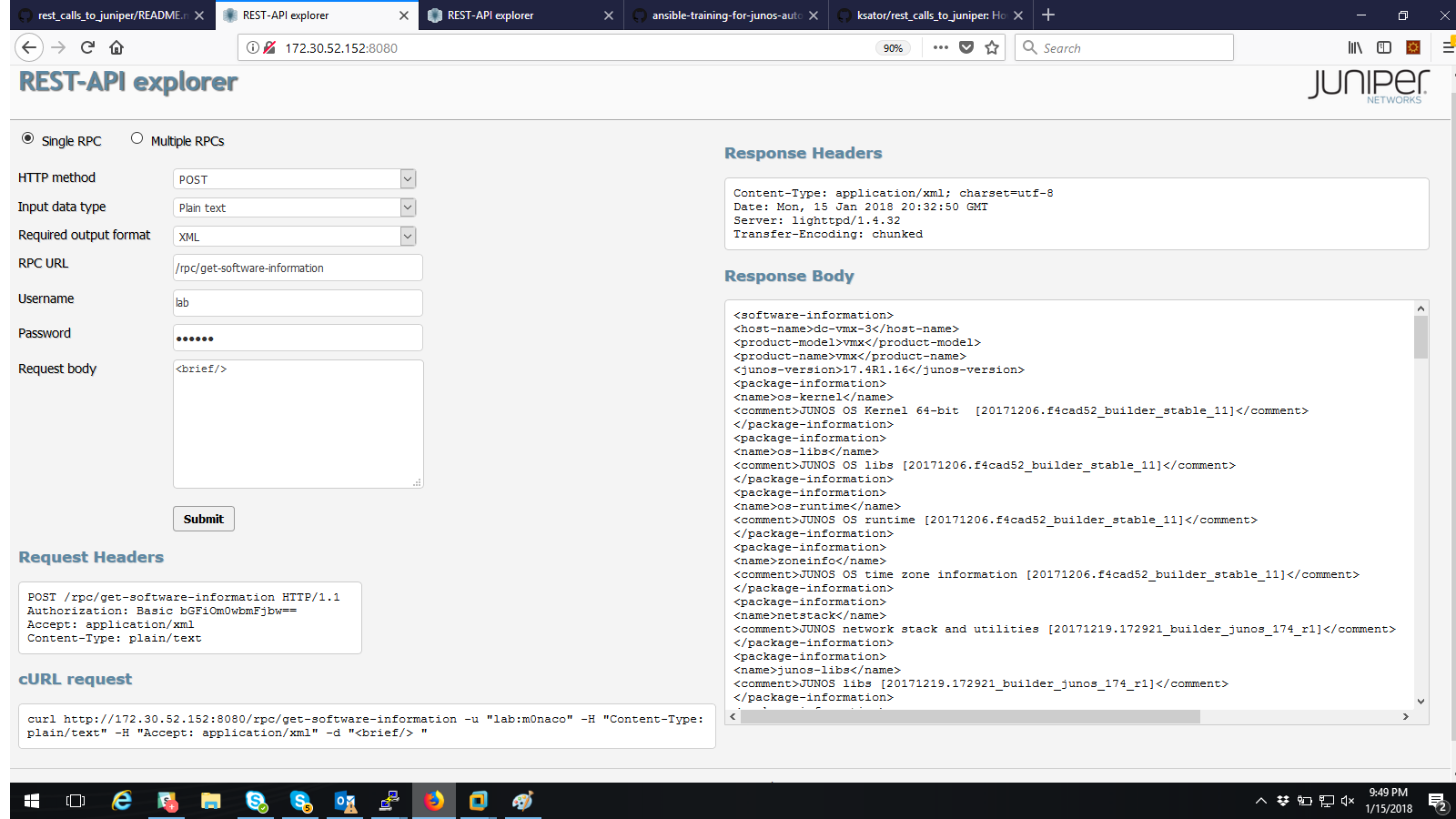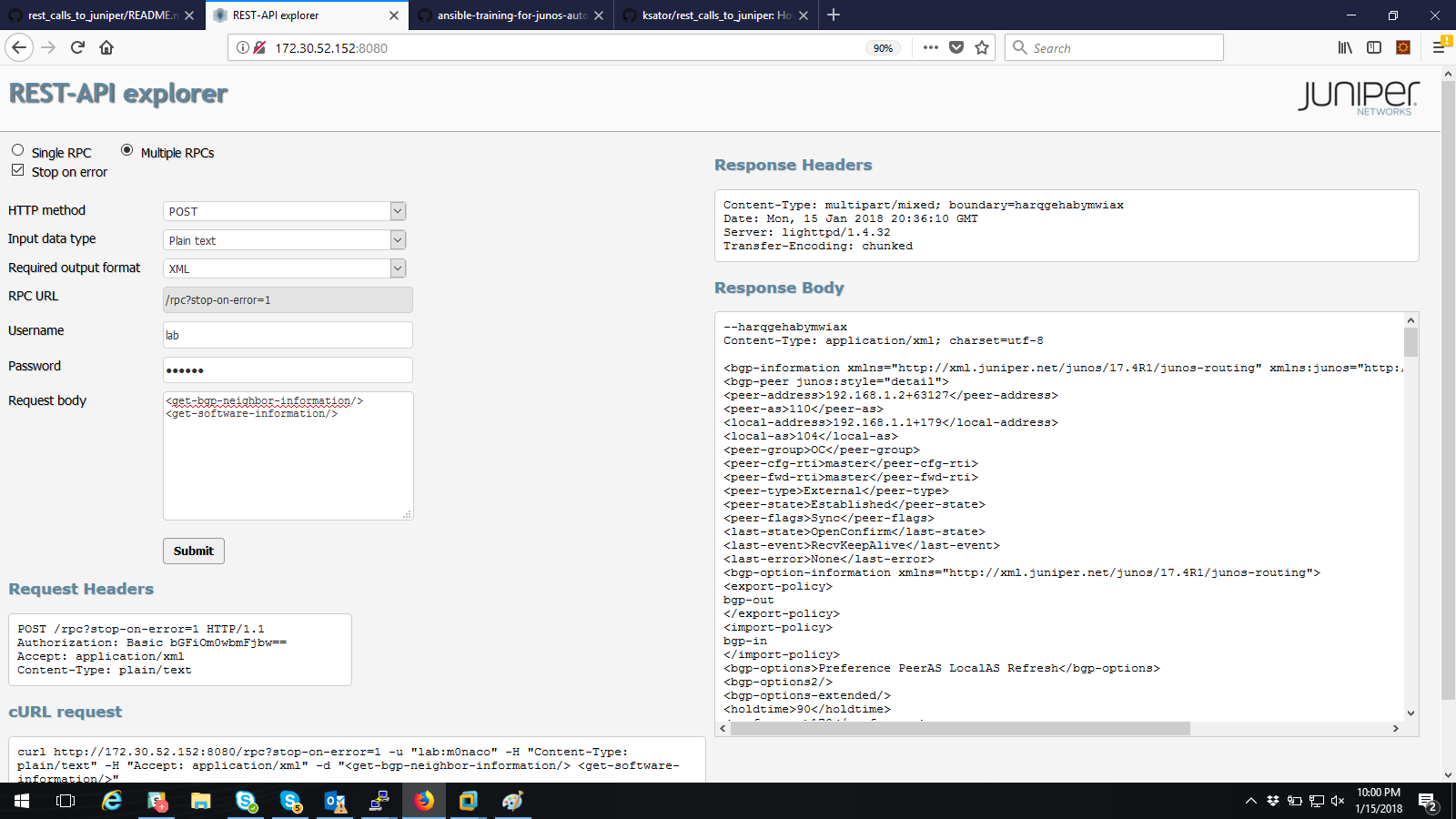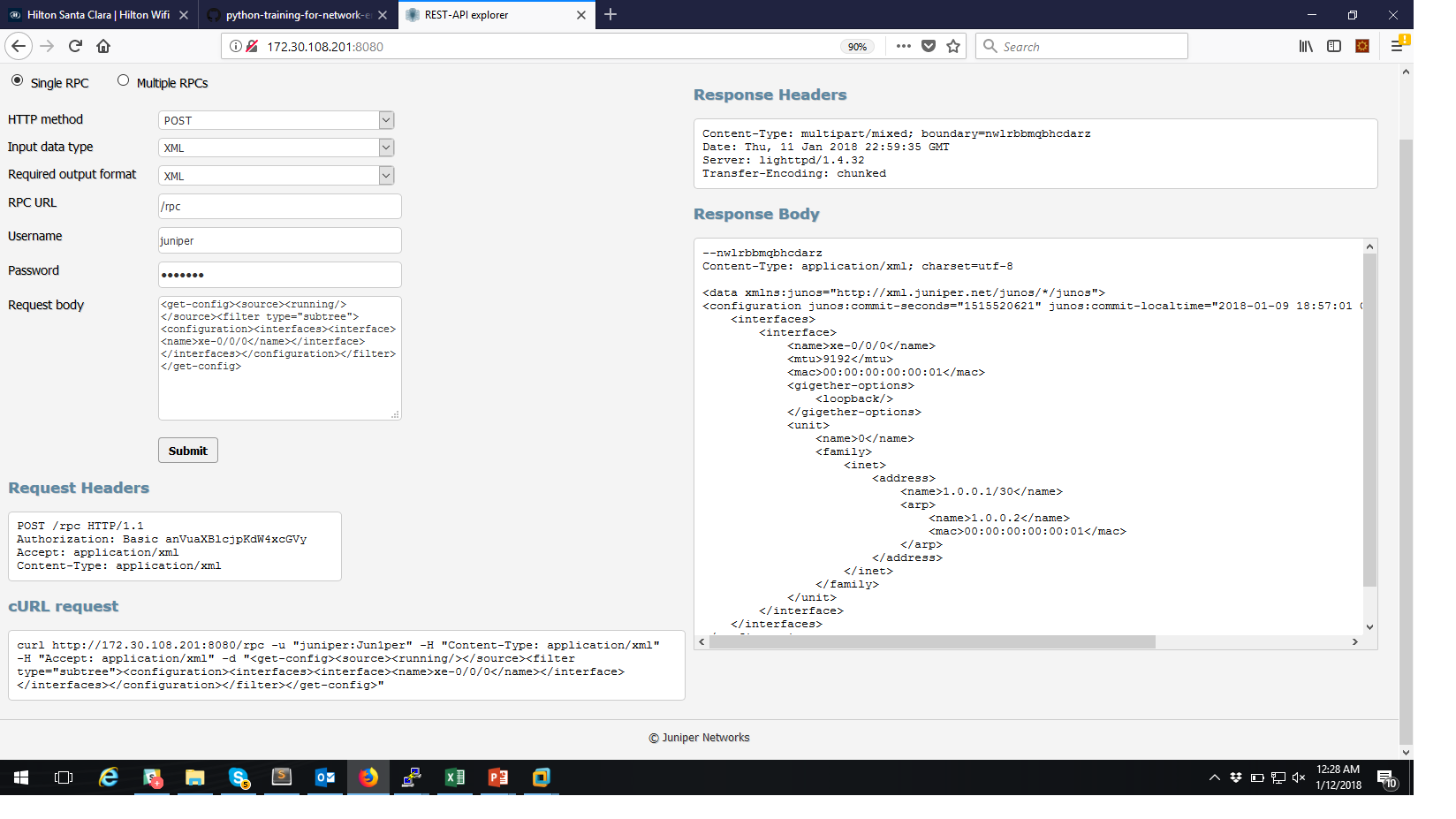- What to find in this repository
- About REST API
- REST calls with Python
- REST calls with Ansible
- How to get locally the content of the remote repository
- JUNOS REST API
- Looking for more Junos automation solutions
This repository has basic REST calls examples for Junos.
Junos, Junos space, Contrail, Northstar, ... have REST API.
You first need to get the REST API documentation for your system.
Then you can use a graphical REST Client (REST Easy, RESTClient, Postman, ...) to start playing with REST APIs and learn more about REST APIs.
Graphical REST clients are for humans, so if you need automation and programmatic access, you have to use other sorts of REST clients. You can then use Python as a REST Client to handle REST Calls.
We can use Python librairies to make REST calls. I am using the library requests.
Example: google map has a public API (read only). The python script google_map_api.py prompts you for an address, and then uses the google map API to get data with a JSON representation for that address, and then parses the JSON output and prints the address latitude and longitude. Run this command to use it:
$ python google_map_api.py
which address: 41 rue de villiers neuilly sur seine
latitude is 48.8890315
longitude is 2.2806278
We can use Ansible to make rest calls. I am using the module uri.
sudo -s
git clone https://github.com/ksator/junos_automation_with_rest_calls.git
cd junos_automation_with_rest_calls
ls
You can now use the local copy of this remote repository.
You can use HTTP get and post methods to submit RPCs to the REST Server.
You can retrieve data in XML or JSON.
REST configuration is under “system services” (default port is 3000)
REST Explorer is an optional tool (GUI) for testing
it is located here
Each Junos show command has an equivalent RPC.
To get the equivalent RPC of a Junos show command, add | display xml rpc at the end of the show command.
Run this command to get the equivalent rpc of show version (which is get-software-information):
lab@spine-03> show version | display xml rpc
<rpc-reply xmlns:junos="http://xml.juniper.net/junos/17.3R1/junos">
<rpc>
<get-software-information>
</get-software-information>
</rpc>
<cli>
<banner></banner>
</cli>
</rpc-reply>
Some show commands use arguments, so the equivalent rpc require arguments:
Run this command to get the equivalent rpc of show chassis hardware clei-models | display xml. There is one argument in the rpc.
pytraining@mx80-17> show chassis hardware clei-models | display xml rpc
<rpc-reply xmlns:junos="http://xml.juniper.net/junos/17.2R1/junos">
<rpc>
<get-chassis-inventory>
<clei-models/>
</get-chassis-inventory>
</rpc>
<cli>
<banner></banner>
</cli>
</rpc-reply>
Run this command to get the equivalent rpc for show route receive-protocol bgp 192.168.10.4 active-path hidden | display xml. There are several arguments in the rpc.
pytraining@newhostname> show route receive-protocol bgp 192.168.10.4 active-path hidden | display xml rpc
<rpc-reply xmlns:junos="http://xml.juniper.net/junos/12.3R11/junos">
<rpc>
<get-route-information>
<active-path/>
<bgp/>
<peer>192.168.10.4</peer>
<hidden/>
</get-route-information>
</rpc>
<cli>
<banner>{master:0}</banner>
</cli>
</rpc-reply>
Run these commands to enable REST API on Junos. The default port is 3000.
The below commands also enable a graphical REST API Explorer that allows to conveniently experiment with REST APIs.
lab@dc-vmx-3> show configuration system services rest | display set
set system services rest http
set system services rest enable-explorer
Junos REST API explorer is an optional graphical tool for testing Junos REST API. It is embeded in Junos, and allows to conveniently experiment with REST APIs.
Here's how to use the Junos REST API explorer to make a REST call to get Junos data in XML. This example uses an HTTP GET. The RPC is get-software-information. There is no argument in the RPC. This is the equivalent of show version | display xml. The default port is 3000, but I am using 8080 in this example.

Here's how to use the Junos REST API explorer to make a REST call when there are arguments in the RPC. This is the equivalent of show version brief | display xml. The RPC is get-software-information and the RPC argument is <brief/>.
lab@jedi-vmx-2-vcp> show version brief | display xml rpc
<rpc-reply xmlns:junos="http://xml.juniper.net/junos/17.2R1/junos">
<rpc>
<get-software-information>
<brief/>
</get-software-information>
</rpc>
<cli>
<banner></banner>
</cli>
</rpc-reply>
In that case, we use an HTTP POST, despite it only being to read data. The default port is 3000, but I am using 8080 in this example.

Here's how to use the Junos REST API explorer to make a REST call with several RPC. In this case, we use an HTTP POST, despite it is only to read data. The default port is 3000, but I am using 8080 in this example.

Here's how to use the Junos REST API explorer to make a REST call with filters to get Junos data. This example uses an HTTP POST. This is the equivalent of show configuration interfaces ge-0/0/0 | display xml. The default port is 3000, but I am using 8080 in this example.

curl is an open source command line tool for transferring data.
Run this command to retrieve and print the software information in a XML representation from a vMX router with a REST call. It's an HTTP GET. The rpc get-software-information is the equivalent of show version.
$ curl http://172.30.52.152:8080/rpc/get-software-information -u "lab:m0naco" -H "Content-Type: application/xml" -H "Accept: application/xml"
Run this command to retrieve and print the software information in a JSON representation from an vMX router with a REST call. It's an HTTP GET. The rpc get-software-information is the equivalent of show version
$ curl http://172.30.52.152:8080/rpc/get-software-information -u "lab:m0naco" -H "Content-Type: application/xml" -H "Accept: application/json"
Run this command to retrieve and print the software information in a XML representation from an vMX router with a REST call. This is the equivalent of show version brief | display xml. The RPC is get-software-information and the RPC argument is <brief/>. It's an HTTP POST.
$ curl http://172.30.52.152:8080/rpc/get-software-information -u "lab:m0naco" -H "Content-Type: application/xml" -H "Accept: application/xml" -d "<brief/>"
Run this command to make a REST call with several RPC. In this case, we use an HTTP POST, despite it only being to read data. The list of RPC is get-bgp-neighbor-information and get-software-information. The default port is 3000, but I am using 8080 in this example.
$ curl http://172.30.52.152:8080/rpc?stop-on-error=1 -u "lab:m0naco" -H "Content-Type: plain/text" -H "Accept: application/xml" -d "<get-bgp-neighbor-information/> <get-software-information/>"
Run this command to retrieve a subset of the junos configuration in a XML representation from an vMX router with a REST call with a filter. It's the equivalent of show configuration interfaces ge-0/0/0 | display xml. It's an HTTP POST.
$ curl http://172.30.52.152:8080/rpc/ -u "lab:m0naco" -H "Content-Type: application/xml" -H "Accept: application/xml" -d "<get-config><source><running/></source><filter type="subtree"><configuration><interfaces><interface><name>ge-0/0/0</name></interface></interfaces></configuration></filter></get-config> "
We can use Python librairies to make REST calls. I am using the library requests.
get_software_information_in_xml.py retrieves and prints the software information in a XML representation from an vMX router with a REST call. It uses the HTTP method GET, with the RPC get-software-information and no argument.
$ python junos/get_software_information_in_xml.py
get_software_information_in_json.py script retrieves in a JSON representation the software information from an MX router with a REST API call. It uses the HTTP method GET with the RPC get-software-information and no argument. The JSON response is parsed and some details are printed.
$ python junos/get_software_information_in_json.py
Software version: 17.4R1.16
Host-name: dc-vmx-3
Product name: vmx
get_configuration_with_filter.py script retrieves and print a subset of the Junos configuration from an MX router with a REST API call. It uses a filter to retrieve only a subset of the Junos configuration. It uses the HTTP method POST.
$ python junos/get_configuration_with_filter.py
configure.py script configures a Junos device using a REST API call. It uses the HTTP method POST. It does these operations: lock-configuration, load-configuration, commit and unlock-configuration, and returns an HTTP response code.
$ python junos/configure.py
200
lab@dc-vmx-3> show system commit
0 2018-01-16 10:01:11 UTC by lab via junoscript
lab@dc-vmx-3> show configuration | compare rollback 1
[edit system login]
+ message "welcome to REST demo";
audit_bgp.py script audits a list of devices using a REST API call. It uses the HTTP method GET to retrieve some BGP details in JSON. It uses the RPC get-bgp-neighbor-information. It then parses the JSON output and prints the peers state.
$ python junos/audit_bgp.py
**************************************************
auditing bgp peers state for device 172.30.52.152
session state for peer 192.168.1.2+63127 is Established
**************************************************
auditing bgp peers state for device 172.30.52.153
session state for peer 192.168.1.1+179 is Established
The ansible inventory file is hosts at the root of the repository.
The ansible configuration file is ansible.cfg at the root of the repository.
Devices credentials are in a yaml file in the group_vars directory
These playbooks have been tested using Ansible 2.4.2.0
The playbook pb_rest_call.yml makes rest call to Junos devices and saves the rpc output locally. It also parses the rpc output and prints some details.
$ ansible-playbook junos/pb_rest_call.yml
PLAY [make rest call to Junos devices, save and parse output] *************************************************************************************
TASK [check if some ports are reachable on Junos devices] *************************************************************************************
ok: [dc-vmx-3] => (item=22)
ok: [dc-vmx-4] => (item=22)
ok: [dc-vmx-3] => (item=830)
ok: [dc-vmx-4] => (item=830)
ok: [dc-vmx-4] => (item=8080)
ok: [dc-vmx-3] => (item=8080)
TASK [create device directories] **************************************************************************************************************
changed: [dc-vmx-3 -> localhost]
changed: [dc-vmx-4 -> localhost]
TASK [make rest call to vmx devices] **********************************************************************************************************
changed: [dc-vmx-3 -> localhost]
changed: [dc-vmx-4 -> localhost]
TASK [Print some mx details] ******************************************************************************************************************
ok: [dc-vmx-3] => {
"msg": "device dc-vmx-3 runs version 17.4R1.16"
}
ok: [dc-vmx-4] => {
"msg": "device dc-vmx-4 runs version 17.4R1.16"
}
PLAY RECAP ************************************************************************************************************************************
dc-vmx-3 : ok=4 changed=2 unreachable=0 failed=0
dc-vmx-4 : ok=4 changed=2 unreachable=0 failed=0
$ ls junos
dc-vmx-3 dc-vmx-4 pb_rest_call.yml
$ ls junos/dc-vmx-3/
rpc_output.json
The playbook pb_rest_calls.yml makes several rest calls to several Junos devices and saves the rpc output locally.
$ ansible-playbook junos/pb_rest_calls.yml
PLAY [make rest calls to junos devices] **********************************************************************************************************************************
TASK [check if some ports are reachable on Junos devices] ****************************************************************************************************************
ok: [dc-vmx-4] => (item=22)
ok: [dc-vmx-3] => (item=22)
ok: [dc-vmx-4] => (item=830)
ok: [dc-vmx-3] => (item=830)
ok: [dc-vmx-4] => (item=8080)
ok: [dc-vmx-3] => (item=8080)
TASK [create device directories] *****************************************************************************************************************************************
ok: [dc-vmx-4 -> localhost]
ok: [dc-vmx-3 -> localhost]
TASK [make rest call to vmx devices] *************************************************************************************************************************************
changed: [dc-vmx-3 -> localhost] => (item=get-software-information)
changed: [dc-vmx-4 -> localhost] => (item=get-software-information)
changed: [dc-vmx-3 -> localhost] => (item=get-bgp-neighbor-information)
changed: [dc-vmx-4 -> localhost] => (item=get-bgp-neighbor-information)
PLAY RECAP ***************************************************************************************************************************************************************
dc-vmx-3 : ok=3 changed=1 unreachable=0 failed=0
dc-vmx-4 : ok=3 changed=1 unreachable=0 failed=0
$ ls junos/dc-vmx-3/
get-bgp-neighbor-information_output.json get-software-information_output.json rpc_output.json
https://github.com/ksator?tab=repositories
https://gitlab.com/users/ksator/projects
https://gist.github.com/ksator/